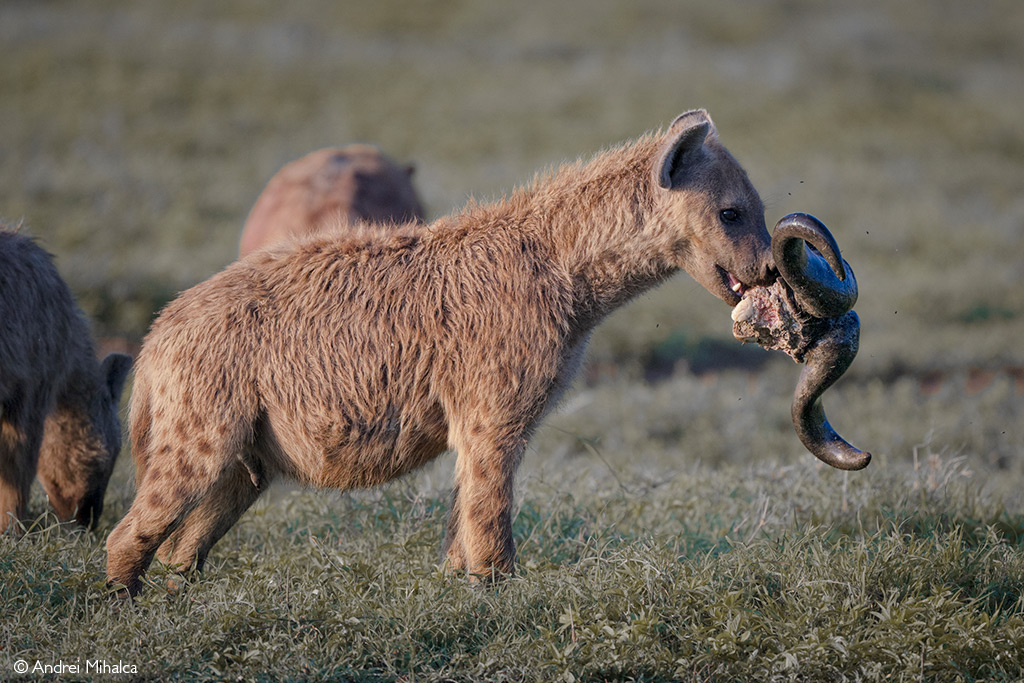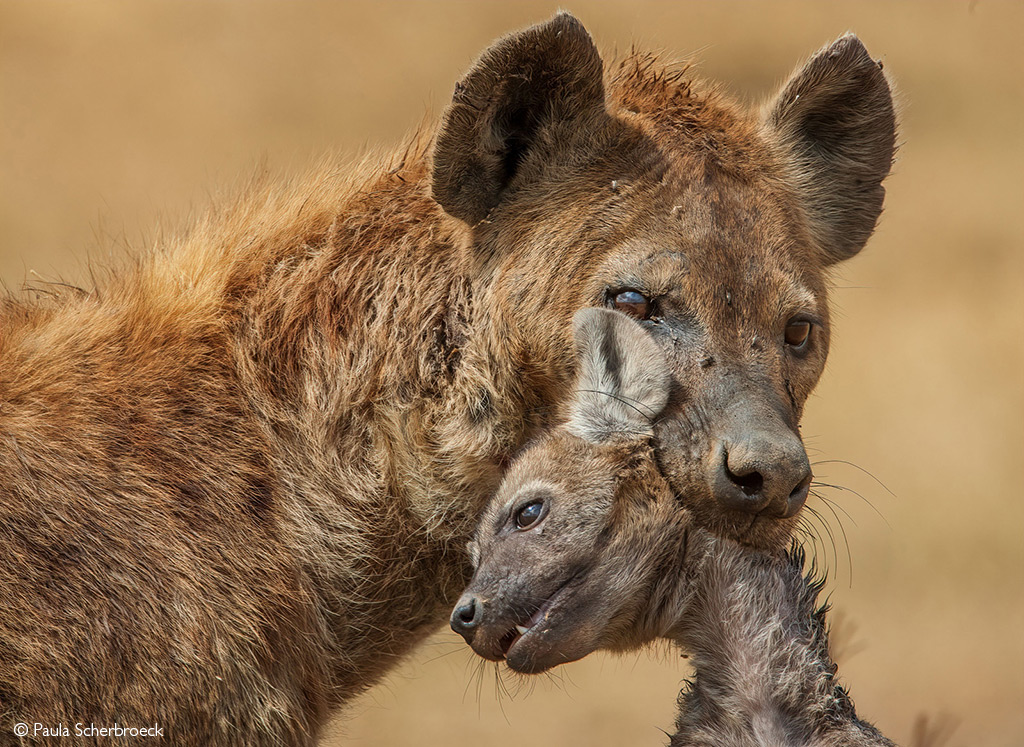
How do you count spotted hyena? For many years, conservationists have struggled to find ways to estimate the population size of animals that are active at night and difficult to identify individually. To get an accurate estimate of the number of hyenas in a reserve, care must be taken not to count the same animal twice. In a new study, a team of researchers used camera trap surveys to determine hyenas’ spatial density across a Tanzanian landscape – providing the first population density estimates of this kind for spotted hyena in Tanzania.
Thriving or diving?
Hyenas have earned a bad reputation from movies like The Lion King, where they are portrayed as the drooling, ‘bad guys’ of the savannah. They have been considered relatively unaffected by human presence and are classified as “Least Concern” by CITES. But the species has lost 24% of its range in the last 40 years and is subject to increased threats from snaring, loss of habitat and a reduced prey base. And with limitations on counting hyena in the past, it is difficult to know if the species is thriving or diving. Knowing how many hyenas there are in a landscape allows conservationists to assess how well a conservation intervention works – if the numbers are low, then something is amiss.
Despite this, there have been relatively few studies on hyenas, at least when compared to lions. Although possibly a more sought-after predator by many safari-goers, the lion is not more important than the hyena. Hyenas play an essential role as a predator and scavenger in the ecosystem. The recent study points out that only three “spatially explicit capture-recapture” (SECR) studies of hyena have been done in East Africa, and none in Tanzania. The “spatially explicit” part is essential: knowing the numbers of hyenas associated with specific habitats or regions gives us much information on what could be driving the numbers (e.g., an area with optimal prey habitat might have a higher density of hyena). The “capture-recapture” is crucial because it allows the researchers to ensure they aren’t double-counting individuals. Usually, this would require “marking” an animal with a ring or a tag, which puts animals under unnecessary stress. To get around this, instead of using tags to identify individuals (to avoid counting the same animal twice), the researchers used the hyenas’ spots.

Spot the difference
The study used camera traps in four surveys across an area recognised as a Key Landscape for Conservation – the Ruaha-Rungwa ecosystem in southern Tanzania. This 45,000 km2 landscape consists of different habitat and land-management types. The researchers used camera trap photos to guide the individual identification of spotted hyena, using the unique spot patterns of the hyenas’ fur to work out who was who in the hyena world. This allowed them to use SECR modelling to estimate spotted-hyena population density at the four survey sites.

Where do hyena roam?
The four camera trap surveys were located in (a) the core area of Ruaha National Park, which is highly protected, productive and is used primarily for tourism; (b) an area of primarily miombo woodland in Ruaha (c) to the north in Rungwa Game Reserve, which is primarily miombo woodland used for trophy hunting activities, and (d) to the east of Ruaha in the community-managed Mbomipa and Waga Wildlife Management Area (WMA), which is similar in productivity to Ruaha but is adjacent to village lands. The Rungwa Game Reserve and Wildlife Management Areas buffer Ruaha.
Notably, there were almost twice as many hyena – 10.8 – recorded per 100km2 in the protected and productive Ruaha National Park, compared to 5.82 in the game reserve and 5.11 in the Wildlife Management Area. Interestingly, a higher density of hyena was associated with a higher density of lions, which raises questions about the role of interspecific competition between lion and hyena. Studies have shown that lions can be a significant source of mortality for hyenas, but other studies have shown that hyenas benefit from lions by stealing their kills.
 Want to plan your African safari to spot hyenas in the wild? We have ready-made safaris to choose from, or start planning a unique safari made just for you.
Want to plan your African safari to spot hyenas in the wild? We have ready-made safaris to choose from, or start planning a unique safari made just for you.
The lower number of hyenas in the WMA is likely due to the greater human disturbance in the WMA, which borders unprotected village land. The cameras recorded evidence of this activity, showing images of snared hyenas and illegal excursions. The closer proximity to humans increases the incidence of human-wildlife conflict, and studies have shown that hyena are often poisoned to reduce cattle predation. This study demonstrates that the protection offered to hyenas – by buffering human contact in the core national park by WMAs and games reserves – works. The core national park may serve as a source population, from which hyenas disperse into the WMAs and game reserves, which act as sinks, as the individuals in these areas face higher mortality risks.
The findings also provide some of the first insights into spotted hyena population ecology in miombo woodland habitat. Estimates from miombo woodland in Ruaha (3.55 per 100km2) and Rungwa (5.82 per 100 km2) were considerably higher than estimates from miombo habitats elsewhere (for example, at 2.62 in Majete Game Reserve, Malawi). Densities in the miombo woodland of Rungwa were likely highest as this area receives high rainfall and likely supports high prey density and, consequently, more hyenas.

The bigger hyena picture
Using spatially explicit density methods allows for a bigger picture to emerge. How the hyena uses the landscape depends on multiple factors that interact and impact population size. Habitat type (productivity in terms of supporting prey numbers) and protection from human-induced mortality (snares and disturbance) seem to have a more significant impact on digits than the presence of other predators (lion and leopard). Knowing this gives conservationists a better idea of what hyenas need to persist in landscapes of mosaic uses and habitats.
Reference and resources
Searle, C.E. et al. (2023). Spotted hyena population density across habitat and land use types in southern Tanzania. Journal of Zoology.
Learn everything there is to know on spotted hyenas here.
Read more about the social networks inherited by hyena here.
Learn about the self-sacrifices made by hyena cubs infected by a microscopic parasite.
Spotted hyenas have elaborate sex lives, and high-ranked male spotted hyenas are more reproductively successful than their low-ranked rivals – read why here.
To comment on this story: Login (or sign up) to our app here - it's a troll-free safe place 🙂.![]()






